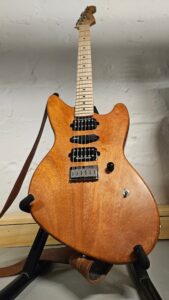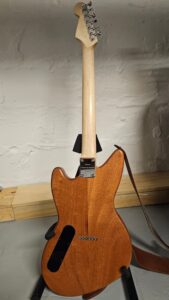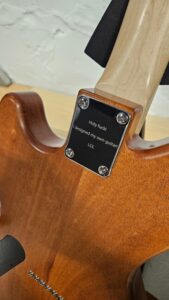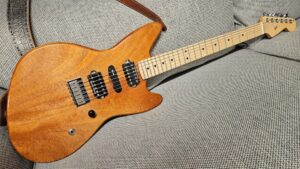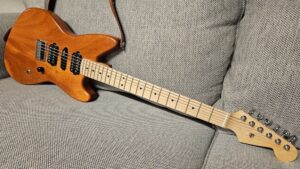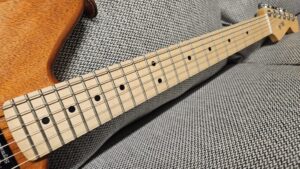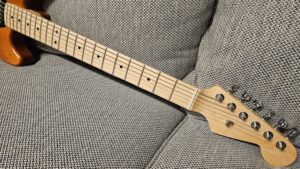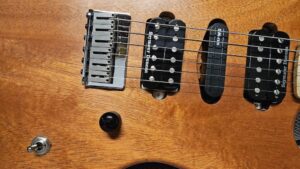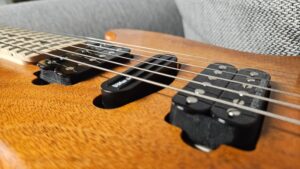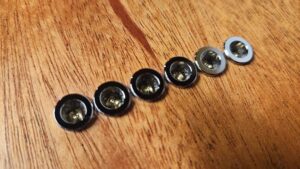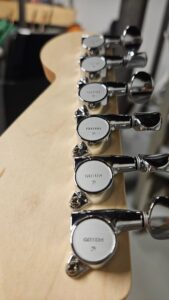To mark my 40th year, I designed a custom partscaster. I actually had the idea for a while, but this seemed like a reasonable occasion to make it a reality.
Here’s how it came to be.
- Background
- Designing the RF40
- Custom partscaster custom body routing
- Custom partscaster custom pickup configuration
- Putting together the custom partscaster
- Tones
- RF40 custom partscaster: conclusion
Background
Why a custom partscaster?
It started with the Billy Corgan Strat. I played one in a store back in Birmingham once and loved the sound. But the neck was too thick, and my brain couldn’t digest a Strat with such a thick neck.
Years later, I was still thinking about it, and pondered adding the DiMarzio loaded scratchplate to my American Standard Strat. But, then I realized: I only ever use the middle pickup on my Strat – why would I spend the guts of $300 on something of which I won’t fully use.
From there, I started thinking about how I only ever use both humbuckers on my Dean Z.
Wouldn’t it be cool to have a guitar that just did those two things?
It didn’t seem like a big ask, but actually, on looking into it…it kind of was.
Research
Obviously, I was looking for a HSH pickup configuration. And the obvious starting point for that is Superstrats. I was looking at Ibanez RGs, and it has every pickup selection apart from the two hmbuckers together. So they were out.
My search led me to the PRS Swamp Ash Special. This was cool because they came out in 1996 – my preferred vintage of guitar. The Swamp Ash Special did have the option to select the middle single-coil pickup by itself, or both humbuckers together. However, they were among many other options. I was exhausted just reading about it.
My next line of thought was: “what if I got a HSH guitar, and jimmied the electronics in it to do just the two sounds I want it to do?”
After researching parts to do that, I didn’t feel like this approach was landing in a way I liked. For example, I couldn’t find a two-way, Strat-style pickup selector to jimmy a Superstrat, and the Swamp Ash Special is a bit expensive for fucking up with amateur electronics.
By now I was also thinking about the controls. My tone knobs on any guitar are always at 10. The only exception to a volume knob not being at 10 is when I’m recording my Strat through my Smokey. So, I don’t really need a tone knob – a single volume knob would do.
And I think this is the point where I started thinking about a custom partscaster.
Designing the RF40
It’s interesting looking back on the design now, and the iterations it went through.
The list of electrics remained unchanged, because they were just copying the things I liked from other instruments.
What am I even trying to copy?
However, to get started, I needed to figure out what pickups were in my Dean. I had suspected they weren’t stock for some time. But, I finally went at it with a screwdriver to see what I could see see see.
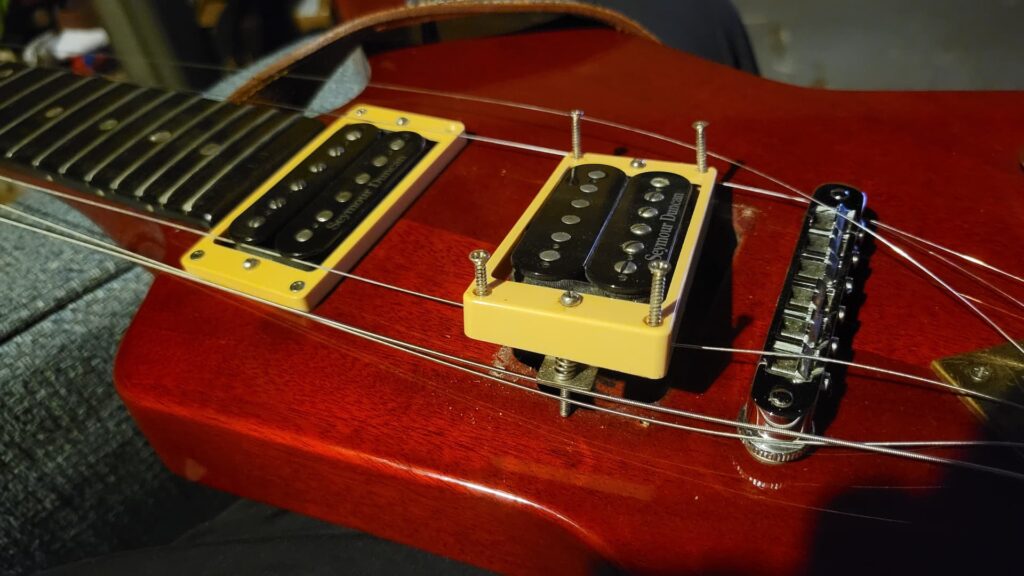
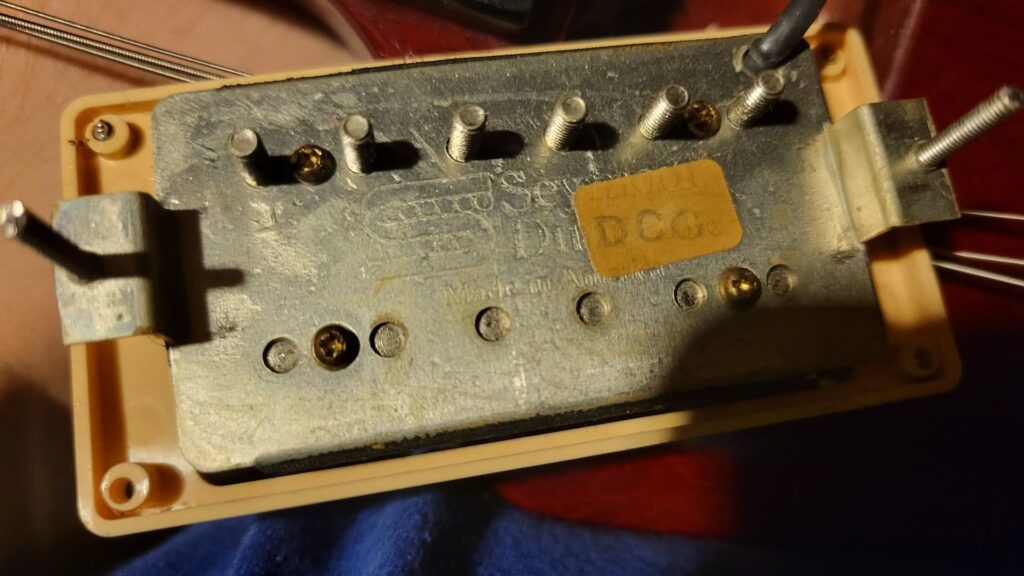
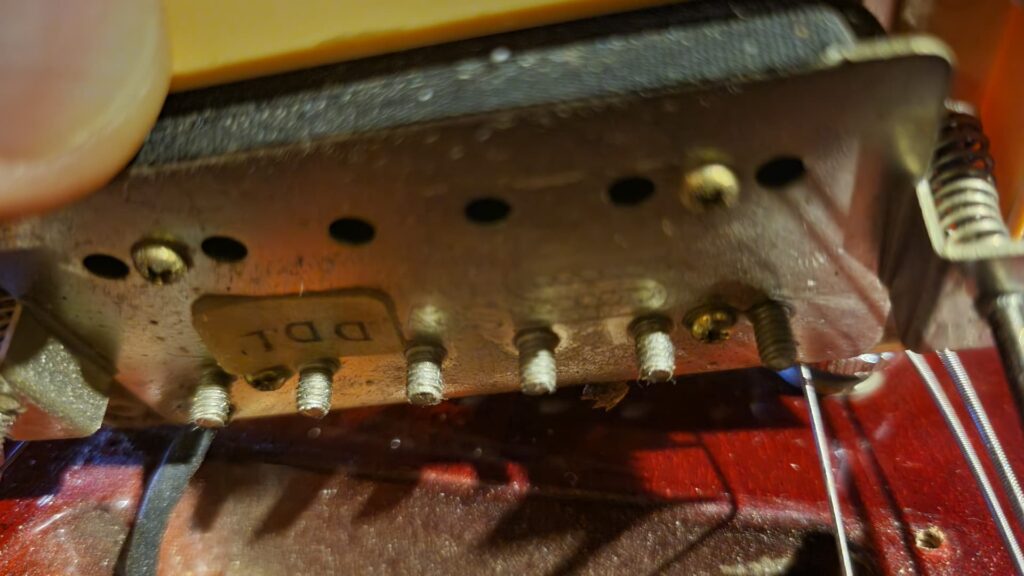
With some sleuthing (Googling) I found this page on the Seymour Duncan website, where I learned that my Dean Z’s neck pickup is a Duncan Custom, and the bridge pickup is a Duncan Distortion. Magic!
A custom partscaster’s shopping list
Now that I knew what humcukers I needed, I was ready to start putting a list together. At least for the electrics.
- Strat-style neck: open to brands, but matching the neck on my 2007 Fender American Standard Stratocaster
- One piece maple neck with black dot inlays.
- Medium “C” profile
- Thickness: 1st- .82″ 12th- .86″
- Fingerboard radius: 9.5″
- Nut width: 1-11/16″
- Scale length: 25 1/2″
- Seymour Duncan Duncan Custom SH-5: same as the neck pickup on my Z
- DiMarzio “The Chopper”: same as middle pickup on the Billy Corgan Strat
- Seymour Duncan Duncan Distortion SH-6b: same as the bridge pickup on my Z
- Two-way pickup selector switch
- Position 1: both humbuckers
- Position 2: center pickup only
- Volume knob
This, and a mahogany body like my Z, remained unchanged from the guitar’s very first iteration.
And yes, I’m aware of the debate surrounding tonewoods. And that’s OK.
Girl, look at that body
While I knew I wanted a mahogany body, I changed my mind a few times when it came to said mahogany body’s shape.
First idea
The first idea was to copy the D’Angelico Premier Brighton, because that was a very fun guitar to play. I’m not a designer, but I tried to visualize my idea with GIMP.
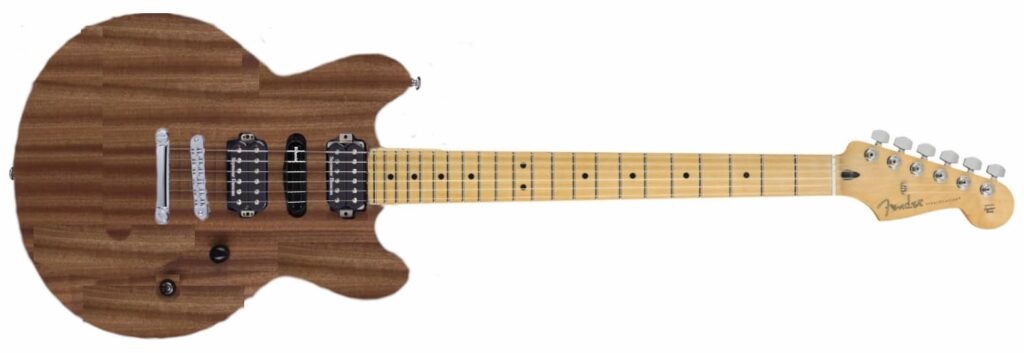
Second idea
Then, I had an idea. It was my custom partscaster, so why not go all-in on the customization, and put my own slant on the design? So, I tried to offset it, and for whatever reason, used a different image of mahogany from Google.
As we can see, I am not a designer.
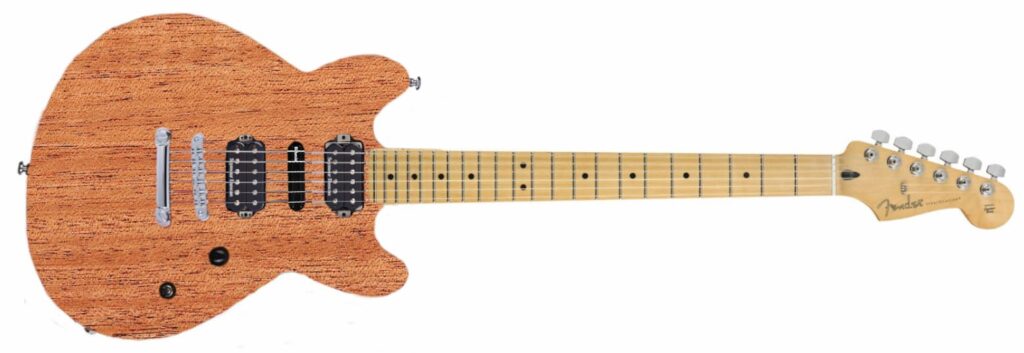
Third idea
The third idea for a body took things a different direction. Up until now, this grand idea for a custom partscaster existed only in a delicate balance between my brain and what I was putting together on my Chromebook.
My 40th year arrived. While I’m typically not a birthday person, I decided that it was as good an excuse as any to make this real.
My wife’s uncle had put together a few guitars. They played nice, so I asked him if he’d put this together for me. He insisted that I get all the parts from Warmoth. The only Warmoth body I felt drawn to was the Jag-Stang.
Nirvana are an important influence, but the stock Jag-Stangs aren’t for me
The Jag-Stang was Kurt trying to amalgamate his favorite bits of a Jaguar and Mustang – this is me trying to amalgamate my favorite bits of my Dean USA Z and American Standard Stratocaster,
Which did this to the design:

The fourth and final idea
Now, the problem was that Warmoth would not do a HSH route for me. So, I started looking at getting the body from Warmoth without any routing, and started reaching out to local luthiers who might do the routing for me.
One of said luthiers was an ass, who glossed over my simple question about routing in the context of my plan, to insist that he build the guitar. I didn’t like his attitude, but in our back and forth, he did bring up some nuances of a Tune-O-Matic bridge that I wasn’t aware of.
As much as the guy annoyed me, he did make me take a closer look at my bridge. After a little more research, I plumped for a nice, simple, Fender American Standard hardtail bridge.

By now, and learning more about the routing, and its cost, I actually ditched Warmoth for the body. After reaching out to a few body manufacturers to explore alternatives, the only one who helped was Rosser Guitars. It was half the cost of the Warmoth one, and I’d read that they played nicely with a Warmoth neck.
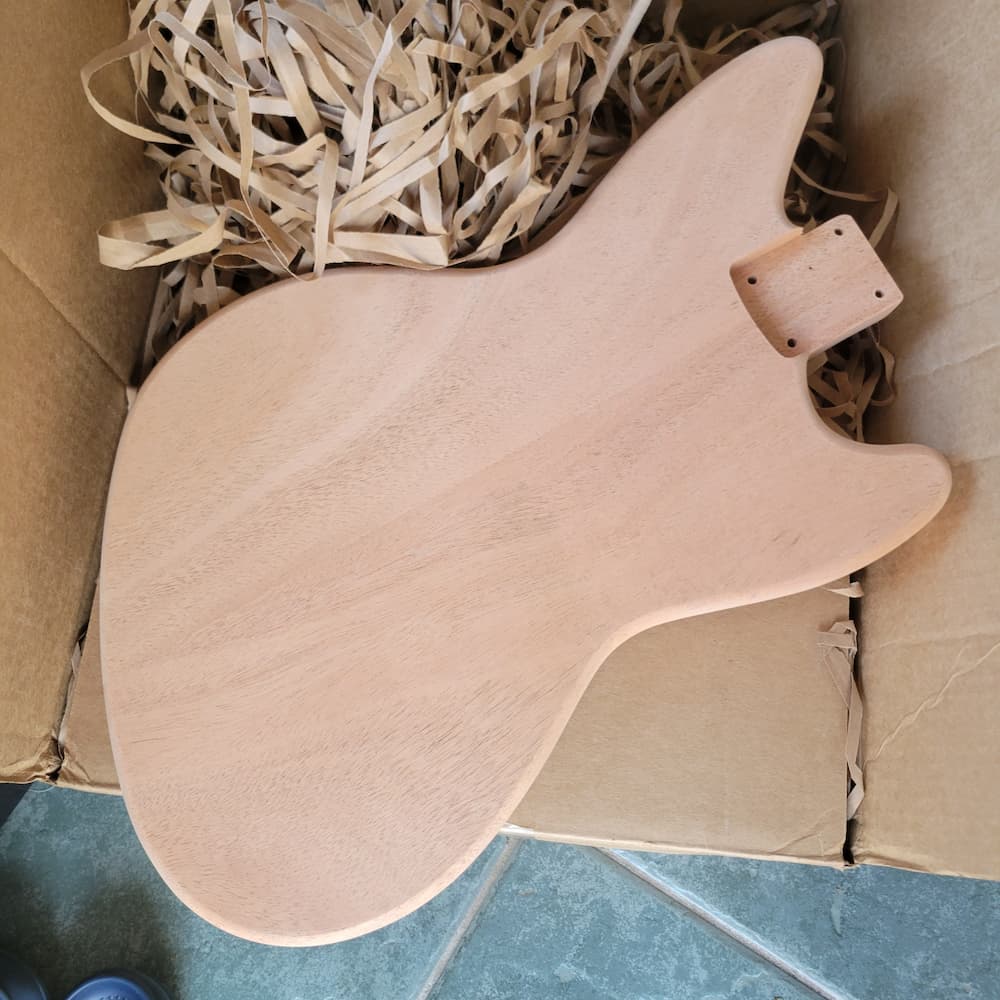
In addition to the neck from Warmoth, I got the bridge, Gotoh tuners, and ferrules.
The parts list was complete!
Custom partscaster custom body routing
There aren’t too many luthiers in NYC who could/would do the HSH routing on the Jag-Stang body.
- Sadowsky only works on his own guitars
- One guy was getting evicted from his workshop
- The aforementioned guy who seemed like a jerk
I landed with Paul Nieto of Guitartech. It was a ballache, because his shop was 40 minutes there and back, and the only time I could get to him was during the work day – although he’s open until 7pm, I’m immediately a dad when 5pm hits.
That aside, boy, did I learn a lot here!
Naively, I figured I could just bring him the body, and he’d route what I wanted from templates. Nope! He asked me to bring him the neck and tuners also. OK, this would have been the starting point of fucking this up if I’d gone at it myself!
So, I brought him the neck, and tuners, and the rest of my order from Warmoth. I was spreading the cost so I hadn’t ordered the pickups yet.
And my: what a thrill lay ahead in ordering them.
Custom partscaster custom pickup configuration
As noted above, I intended to get a Seymour Duncan Custom as the neck pickup for my custom partscaster.
So, I hit Google, and Reverb, and eBay looking for bargains. Except…I couldn’t find a Custom for the neck position. Everything said it was for the bridge.
Curious.
I did some asking on the Seymour Duncan subreddit, and reached out to the company directly to try and figure out what the heck was in the neck of my Z.
After some back and forth with Chris at Seymour Duncan, he concluded that it was either a custom pickup, or a mislabeling.
How exciting!? I’d love to meet the person who put that in!
I gave the Z to Paul to confirm the output, and check for any other suprises. There were none, so I ordered my pickups. He commented that it was a very loud pickup combination. I replied, “Yeah. Yeah it is.”
The pickups came from Sweetwater. The rest of the electronics – knob, pot, switch, jack, and jackplate all came from Phildadelphia Luthier Tools, as well as the strap buttons, string trees, and a wonderful custom engraved neck plate.
Putting together the custom partscaster
With the parts bought, Paul got started on the routing. A couple of weeks later I think, he called to say it was assembled for me to have a play.
He assembled it to get the the routing accurate for the bridge and pickups, but hadn’t finished the body, just in case there was any further work to be done.
It was very exciting! He had overwired it, adding a push-pull to the volume knob, so that it essentially had a Strat mode and a Les Paul mode. Which was great, and very impressive work, but not what I wanted. I found it a fiddle to get to the two selections I wanted.
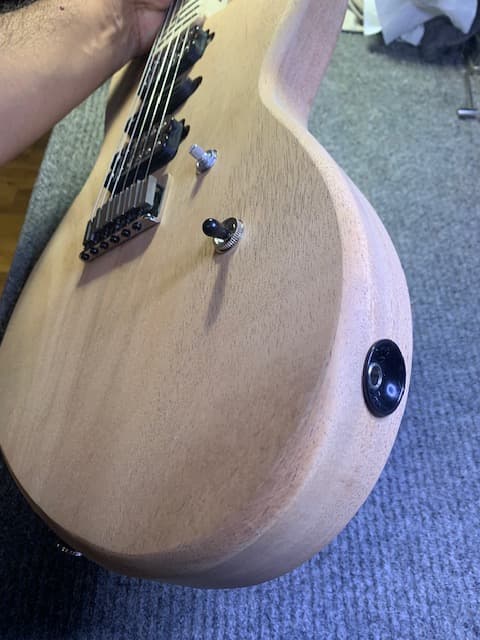
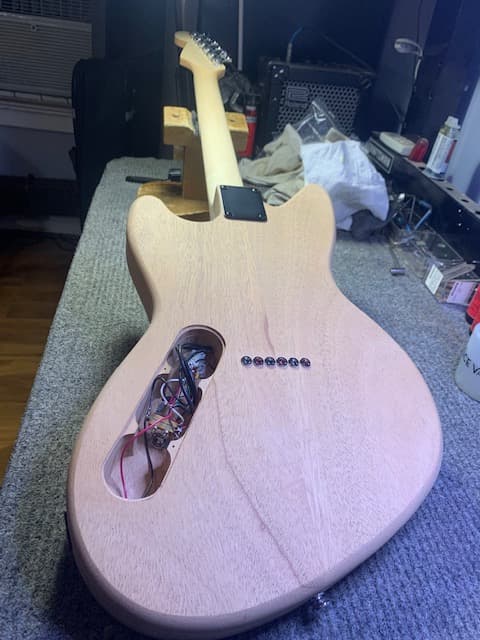
What was funny was that everybody I showed the design to questioned the pickup configuration I wanted. When I went through what I wanted with Paul, he replied, “That’s not a very versatile guitar.”
“I’m not a very versatile player,” I replied.
Regardless, the next step was finishing the body. After that he assembled it again, and invited me in for another play through.
It sounded fucking immense.
Custom partscaster…assemble!
However, as noted above, my wife’s uncle was going to assemble this guitar. I was essentially getting Paul to make it as bulletproof as possible for him to assemble. So, I returned to Paul’s shop a couple of weeks later to pick up the disassembled guitar.
Then I shipped it to my wife’s uncle. And upon receipt he said he wasn’t going to put it together. My wonderful wife drove more than an hour each way to retrieve it.
I shipped it back to Paul for final assembly.
The bench time for Paul to assemble it, disassemble it, then assemble it again turned the RF40 into the most expensive guitar I’ve ever paid for.
But, I went back to his shop and plugged it in. Holding a guitar you designed, to your specs, that leans into how you play is a very special feeling.
Tones
I was excited to share my custom partscaster with the world, so I whipped together this quick demo video the day I picked it up.
Friends, I was in love. It was making the exact racket I needed. The combined bridge and neck humbuckers growled, and the middle pickup squealed.
But, I wanted to do a proper deep dive. I made another video of that. It’s more than 8 minutes long, so you need to be a real nerd, but here’s what it covers:
- What it sounds like
- Intention of design and deciding parts
- Comparison to the guitars it’s intended to stand in for
- How I’ll use it in recording
It was good to do this video. Because I don’t play at particularly loud volumes, I can typically hear the actual direct acoustic strumming of electric guitars, so micing it up helped me to really zone in on the differences.
The part of the video where I realized how much brighter both humbuckers sound than my Z was actually a real shock. Not in a bad way. It was just surprising. It sounds punk as all hell.
I had read that not having a tone knob would increase treble, but I wasn’t ready for that. Then after, I also read that longer scale length also increases the brightness of a guitars sound – the RF40 has a longer scale length than my Z. I still go back and forth between trying to fatten it up.
RF40 custom partscaster: conclusion
It’s certainly been an interesting journey, from the earliest inkling that a custom build might be the most appropriate route for what I wanted, through the research and design, and finally having it in my hands.
If it was to be played by someone other than me, I can imagine it being liked by a punk or grunge guitarist.
I’ve had it for almost a year now, so I can write this with calm, and clarity, and reflection.
| Pros | Cons |
| Tone! Although minimalist, it really is exactly what I want. I’ve barely touched my other guitars since I got it. | Opinions. Everyone had some. Especially when you have non-traditional pickup selections. You have to remind yourself that it’s your guitar, and not to take it to heart. |
| Vibes. Because just look at it! And the fact that it came from my brain gives additional vibes of excitement every time I pick it up. | Price. When I first started thinking about it, I thought it would be about $700 total. Lol. So while not necessarily a con, I suspect others might also be surprised by how pricey a partscaster can get. |
If you found this helpful, subscribe! You’ll be notified of new posts on Thursdays, inspiring you going into the weekend.
And share why you found it helpful. Because it helps us, and others!
Feel free to shoot me a coffee
